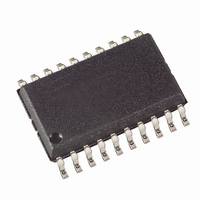ATTINY861-20SU Atmel, ATTINY861-20SU Datasheet - Page 37

ATTINY861-20SU
Manufacturer Part Number
ATTINY861-20SU
Description
IC MCU AVR 8K FLASH 20MHZ 20SOIC
Manufacturer
Atmel
Series
AVR® ATtinyr
Datasheet
1.ATAVRMC321.pdf
(242 pages)
Specifications of ATTINY861-20SU
Core Processor
AVR
Core Size
8-Bit
Speed
20MHz
Connectivity
USI
Peripherals
Brown-out Detect/Reset, POR, PWM, WDT
Number Of I /o
16
Program Memory Size
8KB (4K x 16)
Program Memory Type
FLASH
Eeprom Size
512 x 8
Ram Size
512 x 8
Voltage - Supply (vcc/vdd)
2.7 V ~ 5.5 V
Data Converters
A/D 11x10b
Oscillator Type
Internal
Operating Temperature
-40°C ~ 85°C
Package / Case
20-SOIC (7.5mm Width)
Cpu Family
ATtiny
Device Core
AVR
Device Core Size
8b
Frequency (max)
20MHz
Interface Type
USI
Total Internal Ram Size
512Byte
# I/os (max)
16
Number Of Timers - General Purpose
2
Operating Supply Voltage (typ)
3.3/5V
Operating Supply Voltage (max)
5.5V
Operating Supply Voltage (min)
2.7V
On-chip Adc
11-chx10-bit
Instruction Set Architecture
RISC
Operating Temp Range
-40C to 85C
Operating Temperature Classification
Industrial
Mounting
Surface Mount
Pin Count
20
Package Type
SOIC
Processor Series
ATTINY8x
Core
AVR8
Data Bus Width
8 bit
Data Ram Size
512 B
Maximum Clock Frequency
20 MHz
Number Of Programmable I/os
16
Number Of Timers
2
Operating Supply Voltage
2.7 V to 5.5 V
Maximum Operating Temperature
+ 85 C
Mounting Style
SMD/SMT
3rd Party Development Tools
EWAVR, EWAVR-BL
Development Tools By Supplier
ATAVRDRAGON, ATSTK500, ATSTK600, ATAVRISP2, ATAVRONEKIT, ATAVRMC320
Minimum Operating Temperature
- 40 C
For Use With
ATSTK600 - DEV KIT FOR AVR/AVR32ATAVRBC100 - REF DESIGN KIT BATTERY CHARGER770-1007 - ISP 4PORT ATMEL AVR MCU SPI/JTAG770-1004 - ISP 4PORT FOR ATMEL AVR MCU SPI
Lead Free Status / RoHS Status
Lead free / RoHS Compliant
Available stocks
Company
Part Number
Manufacturer
Quantity
Price
7.1.2
7.1.3
7.1.4
7.2
7.3
2588E–AVR–08/10
Power Reduction Register
Minimizing Power Consumption
ADC Noise Reduction Mode
Power-Down Mode
Standby Mode
Idle mode enables the MCU to wake up from external triggered interrupts as well as internal
ones like the Timer Overflow. If wake-up from the Analog Comparator interrupt is not required,
the Analog Comparator can be powered down by setting the ACD bit in the Analog Comparator
Control and Status Register – ACSR. This will reduce power consumption in Idle mode. If the
ADC is enabled, a conversion starts automatically when this mode is entered.
When the SM1:0 bits are written to 01, the SLEEP instruction makes the MCU enter ADC Noise
Reduction mode, stopping the CPU but allowing the ADC, the external interrupts, and the
Watchdog to continue operating (if enabled). This sleep mode halts clk
while allowing the other clocks to run.
This mode improves the noise environment for the ADC, enabling higher resolution measure-
ments. If the ADC is enabled, a conversion starts automatically when this mode is entered. Apart
form the ADC Conversion Complete interrupt, only an External Reset, a Watchdog Reset, a
Brown-out Reset, an SPM/EEPROM ready interrupt, an external level interrupt on INT0 or a pin
change interrupt can wake up the MCU from ADC Noise Reduction mode.
When the SM1:0 bits are written to 10, the SLEEP instruction makes the MCU enter Power-
down mode. In this mode, the Oscillator is stopped, while the external interrupts, and the Watch-
dog continue operating (if enabled). Only an External Reset, a Watchdog Reset, a Brown-out
Reset, an external level interrupt on INT0, or a pin change interrupt can wake up the MCU. This
sleep mode halts all generated clocks, allowing operation of asynchronous modules, only.
When the SM1:0 bits are written to 11 and an external crystal/resonator clock option is selected,
the SLEEP instruction makes the MCU enter Standby mode. This mode is identical to Power-
down with the exception that the Oscillator is kept running. From Standby mode, the device
wakes up in six clock cycles.
The Power Reduction Register (PRR), see
vides a method to stop the clock to individual peripherals to reduce power consumption. The
current state of the peripheral is frozen and the I/O registers can not be read or written.
Resources used by the peripheral when stopping the clock will remain occupied, hence the
peripheral should in most cases be disabled before stopping the clock. Waking up a module,
which is done by clearing the bit in PRR, puts the module in the same state as before shutdown.
Module shutdown can be used in Idle mode and Active mode to significantly reduce the overall
power consumption. In all other sleep modes, the clock is already stopped. See
of I/O modules” on page 197
stopped.
There are several issues to consider when trying to minimize the power consumption in an AVR
controlled system. In general, sleep modes should be used as much as possible, and the sleep
mode should be selected so that as few as possible of the device’s functions are operating. All
functions not needed should be disabled. In particular, the following modules may need special
consideration when trying to achieve the lowest possible power consumption.
for examples. In all other sleep modes, the clock is already
“PRR – Power Reduction Register” on page
I/O
, clk
CPU
“Supply Current
, and clk
39, pro-
FLASH
37
,



















